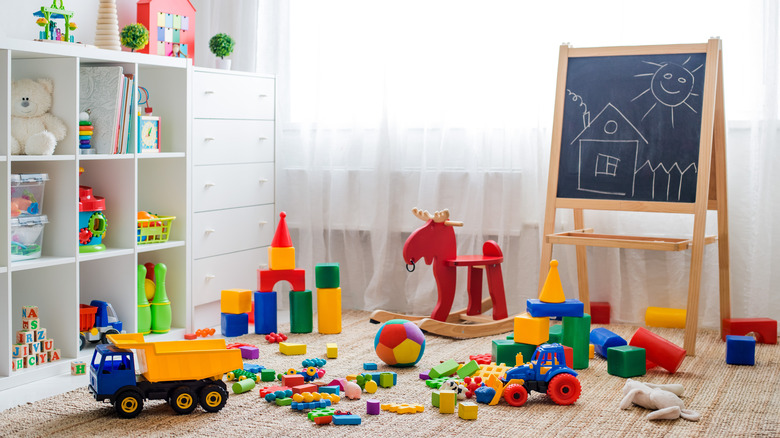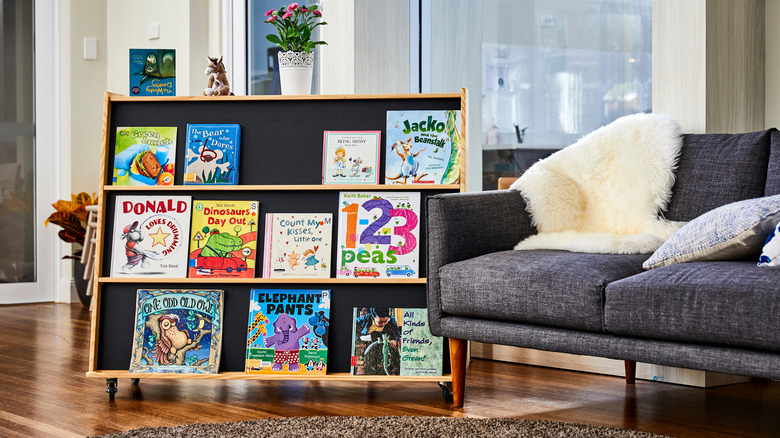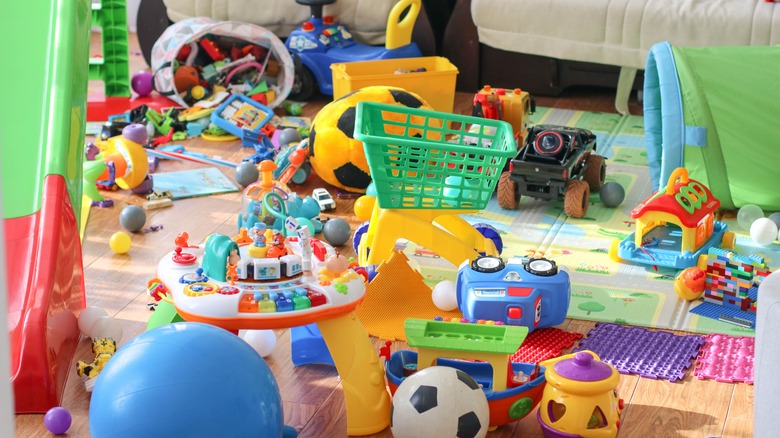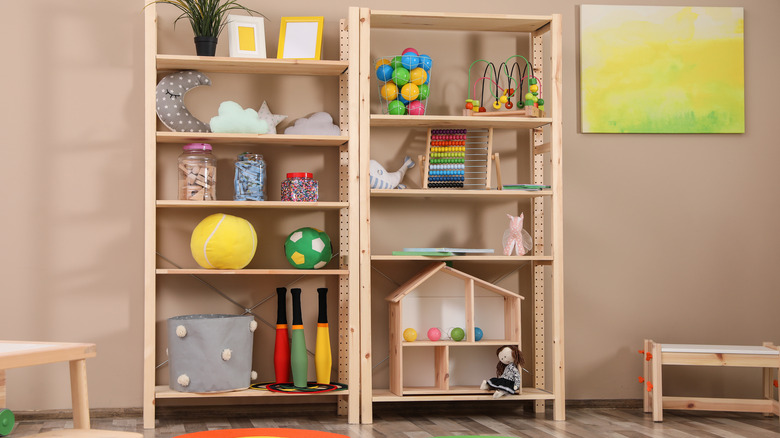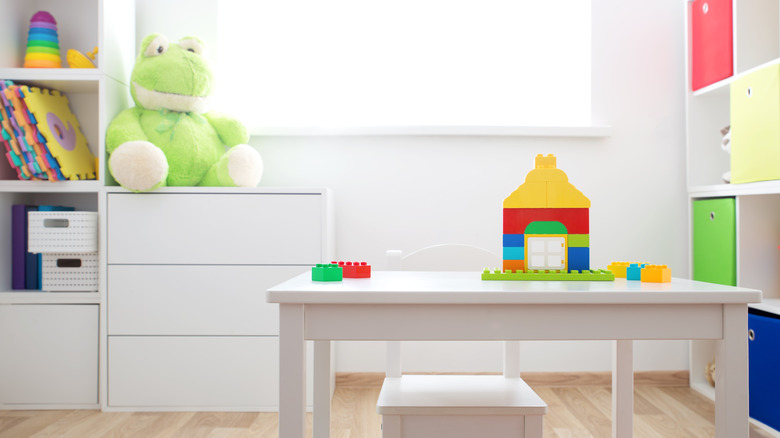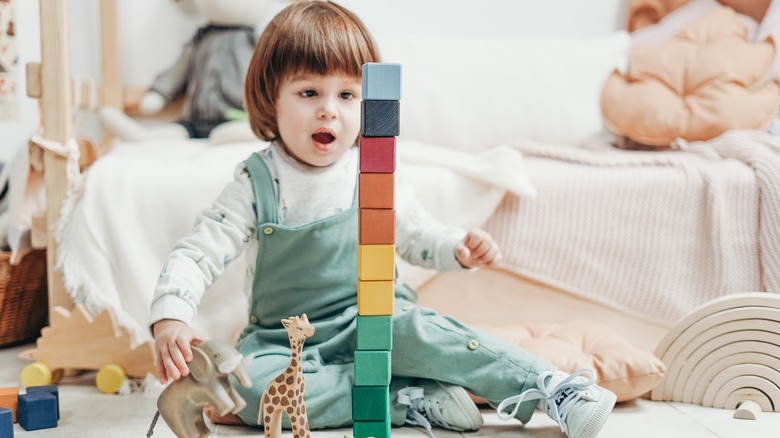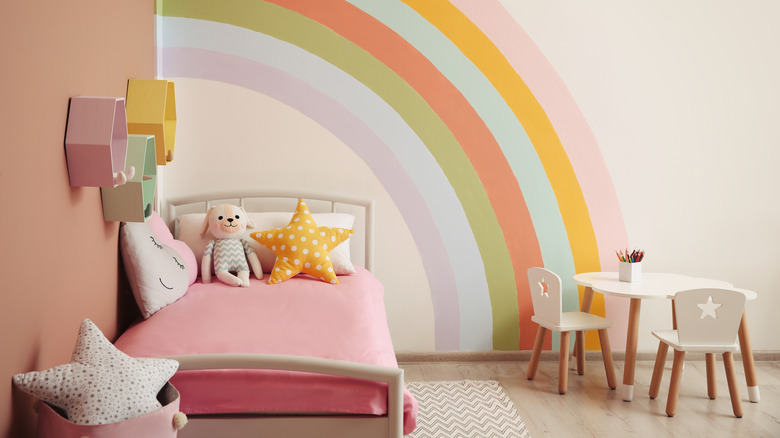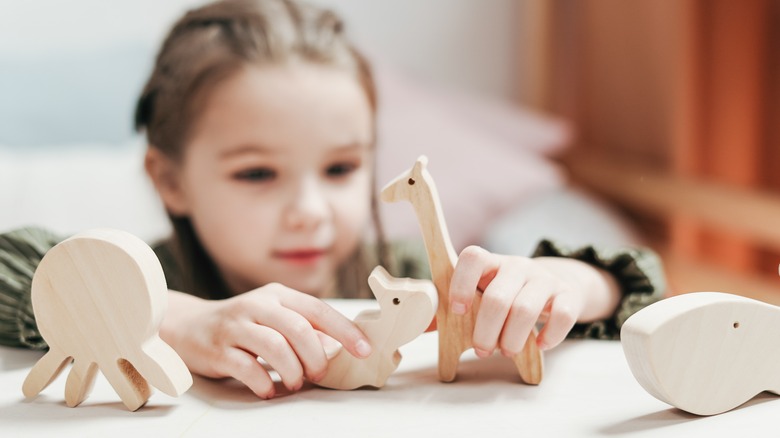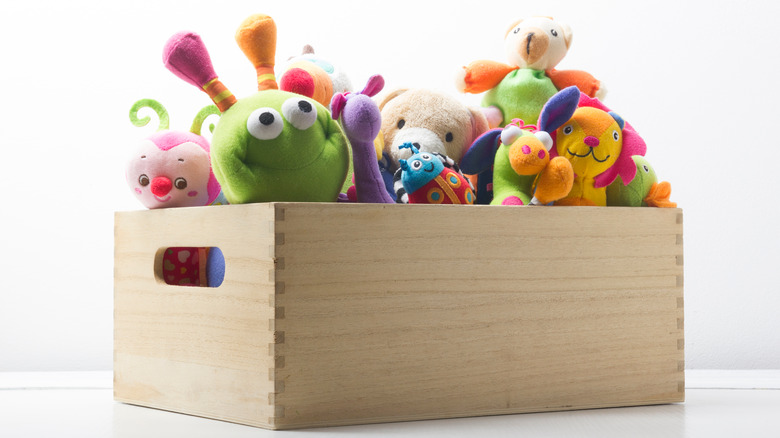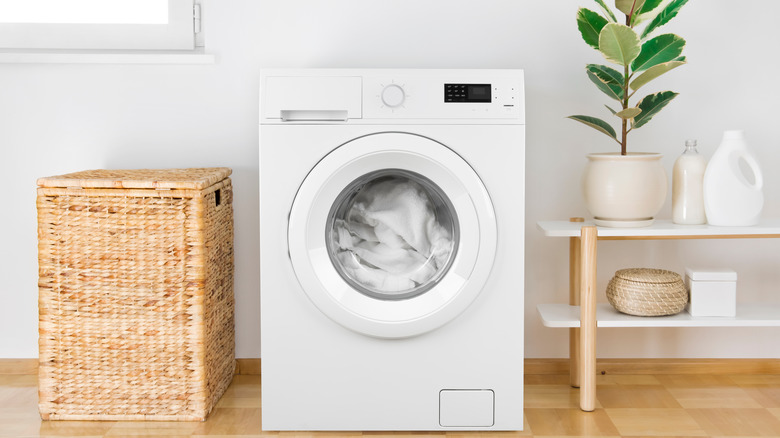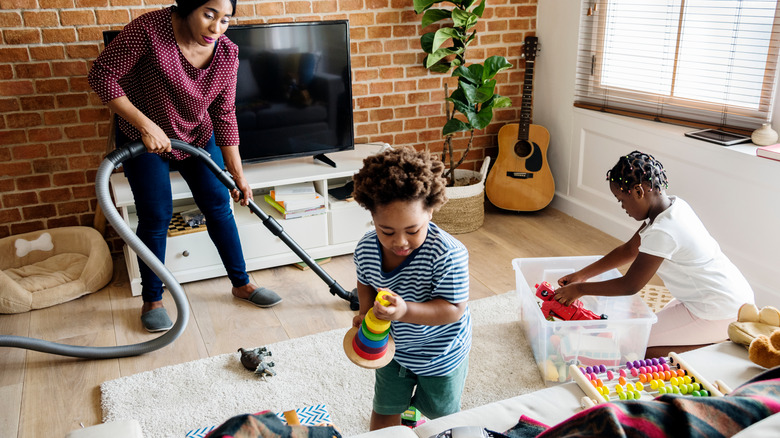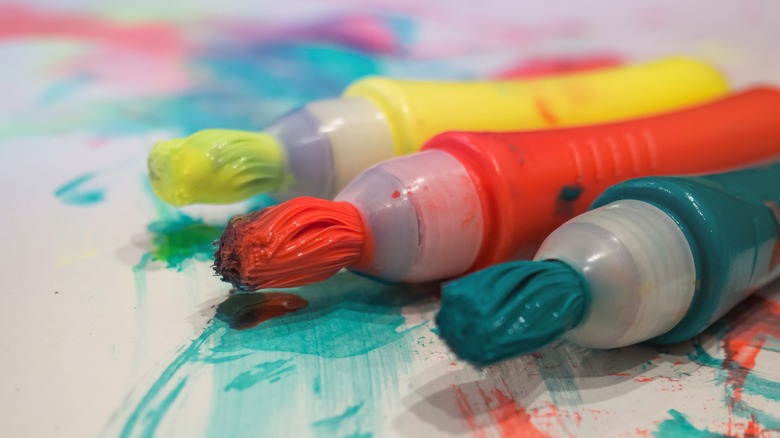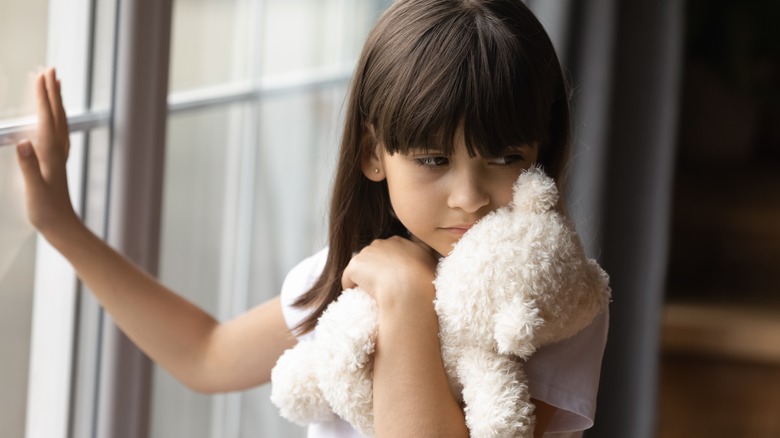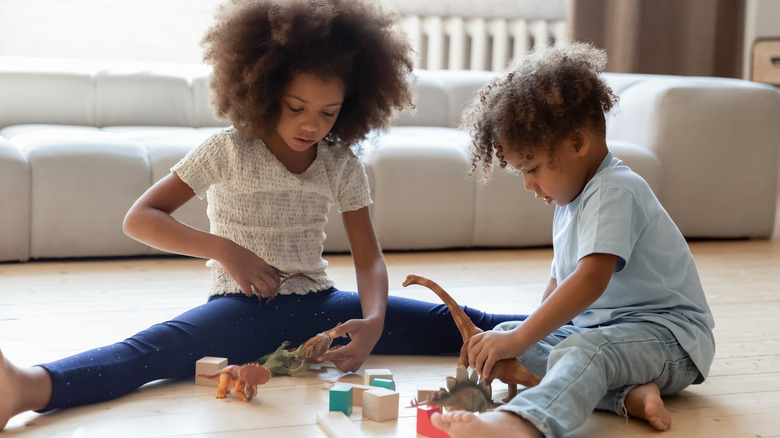Mistakes Parents Make When Decorating A Playroom
Designing a suitable playroom is a big deal for parents with young children. Before designing a playroom, much thought goes into finding proper furniture, creating a safe space, and buying age-appropriate toys and games. According to The Organized Mama, it should be obvious where certain items go when setting up this space. Toys that are the same type should stay together. It's also beneficial to keep toys within the room and not scattered around various areas of the home. The main idea is to be organized and not push everything against the walls.
Though playrooms are child centric, they shouldn't be overloaded with toys. Try to incorporate toys that stimulate creativity and artistry by having crafts, musical instruments, and puzzles in the space. After all, a kid's room should be child-friendly and safe as well as exploratory and exciting. For those who need assistance in creating the perfect playroom, these are common mistakes parents make.
Insufficient space
Insufficient space isn't detrimental to parents who want to create a children's playroom. They just need to get creative. Families who lack an additional room to design a kids' area could divide their family room into zones, according to Blue i Style. In large rooms, furniture could function as a dividing point, whereas smaller rooms could have a designated corner as a play area. Playroom space should give kids enough room to dance and construct projects. For older children, a table may be suitable to use for tabletop and board game playing.
Another idea for creating more space would be to hook hanging bags on the walls of a room (via Craftaholics Anonymous). These bags could contain specialized items children enjoy based on their own personal interests. Hanging baskets could be found at bath décor and home stores and used to hold toys and other playthings (via Thrifty and Chic). For additional storage, buy a plastic closet organizer to hang over a door to keep small toys intact.
Too much clutter
Children love toys and have a collection of them, but too much of them could produce trouble within the household. The Simple Daisy said to limit the number of toys children have in the playroom to avoid this problem. It may be a promising idea to change out toys every three to six months to cycle out ones that aren't being played with as much. While older kids usually understand how to keep things in order, younger children may need to be reminded to take out only one toy at a time. With practice, children get better at following this rule. Try to declutter the playroom twice a year to cut back on junk. Throw away cheaply made toys or match small missing parts to the correct playthings to cut back on additional trash.
An obvious way to combat clutter would be to keep toys and games in cabinets or on top of shelves (via The Genius of Play). Find portable toys that don't assume too much space, such as collapsible tents and tunnels that could be taken down and moved easily to somewhere else. Pick up toys from the floor to keep a clear footpath, so no one gets hurt by tripping or stepping on anything.
No organization
Having no organization whatsoever could turn playtime into a nightmare. Why not organize toys by type, as prescribed by Modern Minimalism? It'll be less challenging for the child to find what they want to play with at that moment. Keep dolls and stuffed animals together by displaying them on shelves. Cars, trucks, and airplane toys should be stored in bins or plastic containers for safekeeping. Crafty toys such as bead kits or model-making toys should be placed in their own area or bin for when the time is right.
When it comes to the number of toys a playroom should have, try to give children a limit. No more than five board games or six action figures in the playroom at a time may be suitable. This depends on the child's age and how responsible they are with taking care of toys and cleaning up their space. Each type of toy should have its own designated area for play, helping keep the room neat for longer.
Using grown up furniture
One of the mistakes parents make when designing their children's playroom is utilizing furniture that's too grown up or big for them at the current moment in time. Think about what your child needs that could fit into a kiddie design aesthetic. For the child with several picture books, The Strategist suggests finding primary colored storage racks that could be reached at their height. Instead of having a grown-up-sized table in the playroom, find a table that is small enough for a child, as well as something that could have adjustable legs for when they grow in the future. Modular foam couches are another excellent way for kids to be comfortable and use their imagination. These kinds of couches have foam attachments that could be used to build play forts and towers.
Think of spacing in the playroom before deciding on a table (via Crate & Barrel). Small rooms do well with small square or rectangular tables with built-in storage space. Large rooms could do with a long table that could seat four to six kids. There are also adjustable tables on the market, which grow with your children as they advance from toddler to high school ages. You can also create a book nook with shelves low enough for children to reach, and place bean bags or foam chairs nearby for added comfort.
Having a television in the playroom
Parents acknowledge that having too many screens in the home and allowing their children too much screen time isn't the best. When it comes to watching television, Hello Motherhood said that, on average, children ages two to five watch 38 hours per week. Children starting elementary school between the ages of six to eight usually watch 28 hours of television a week. It's advised that parents be more aware of what kind of programs their children are watching, so they aren't influenced by bad behaviors and poor choices displayed on the screen.
Instead of keeping a television in the playroom, build playsets that could spark imagination and creativity. Children enjoy playing with dollhouses with cute family figurines. These could be purchased at local shops and big box toy stores. Kitchen sets are fun for children who want to pretend they're chefs. Faux plastic food could also be purchased at toy stores. For the artistic child, find an easel with blank white paper where they could use washable markers and crayons to make their own artwork. Their artwork could be displayed on the playroom walls to show off their masterpieces.
No creative centers
Children love being creative and imaginative. According to Nurture and Thrive, developing a playroom that children would enjoy spending time in is pertinent. Children love building models of towers, planes, and cars. Why not install peg boards on walls to place small clear plastic containers through peg slots that hold Legos? Not only will these be within reach, but they're easy to see what's inside each container. Another way to store Legos and K'Nex would be to have slide-out storage containers in a drawer within reach for easy building.
Create a craft table with art supplies such as scissors, colored pencils, glue, and construction paper (via No Time For Flash Cards). Buy a paper edger that holds scissors. To keep pom poms and pipe cleaners in order, find mason jars and decorative plastic cups to hold these pieces. What about children who enjoy writing? Devise a writing station with a standing chalkboard and chalk. Magnetic letters could be purchased and used on the chalkboard to help with spelling and sentence structure to make stories.
When it comes to play, children need to get their wiggles out. In a designated corner in the playroom, have a mini trampoline or wood climber for children to jump and play on (via Ducklings Early Learning Center). Also, make sure things in the playroom are age appropriate. For example, change out toddler toys for school-age toys for growing children who still want an area to play and create.
Having blank walls
The idea of a playroom is to make it feel inviting for children. Not having any wallpaper or completely blank walls devoid of color and design won't spark creativity or playfulness in kids. Display child-friendly artwork, as stated by Ideal Home. Thinking of creating a zoo theme for the child's playroom? Buy framed photos of drawn or painted alligators and lions. Incorporate stuffed animals and animal artifacts on the shelves and around the walls.
Another way to fill in the blank spaces of walls in a playroom is to station a colorful sofa up against one wall. Place striped, polka-dotted, and solid colored pillows on the sofa to add pattern and richness to an otherwise pure canvas. For playing dress up in the playroom, establish a space by attaching a hanging rail to a wall to hang costumes. Place a small shelf above the hanging rail with decorative plaques encouraging fun and excitement. And don't neglect the ceiling! A bare ceiling could do with a cool paint job featuring neon stripes or pastel hues.
Things aren't within the child's reach
Keep in mind, children are small and can't reach things as high as adults. To keep things within children's reach, make sure their toys and games are level so they can have access to them easily. As suggested by The Organized Mom, command hooks are a logical option. They could be used for hanging bins that contain coloring pages or worksheets. With stuffed animals, they could be put into tin buckets and hung on the wall. This makes it easier for the child to grab their favorite stuffed dog or crab.
Don't want dress-up costumes strewn all over? Hang them on command hooks. It's simple to place hats and other headgear on the hooks to contain order. Do you want to show off that doll collection or keep play bags and backpacks organized? You guessed it — keep them on display with the help of hooks. This makes it plausible for little ones to grab the dolls and bags and take them wherever they want in the playroom. Why not create grab bags filled with themed toys? One pack could contain plastic dinosaurs, while another bag could have trucks and cars. Children would love the "magic" within these pouches.
Not donating or recycling toys
No one wants to play with toys that are broken, have missing pieces, or aren't age-appropriate anymore. So why not recycle or upcycle these toys? Today's Parent said there are local organizations that will take "tiny toys," meaning toys that are small enough to fit in the palm of someone's hand, to upcycle and turn them into educational toys. These toys usually involve missing doll shoes or broken pieces of plastic. You can also check out Staples in your local area to see if they recycle used highlighters, markers, and pens. And Crayola has a ColorCycle program where empty markers are repurposed and recycled.
Try to teach children about organization when it comes to toys (via The Closet Works). By allowing kids to organize the toys they want and the toys they don't want, they better understand taking care of their prized possessions. They also gain empathy for children in need when they donate once-loved and cherished items. To make decluttering together easier, go by the "keep, pass on, and trash" method. Keep favorite toys, pass on anything old or outgrown to a neighbor, a charity, or a family member, and trash anything broken, with missing pieces, or recently recalled.
Not having safety precautions in place
As well as making a fun playroom, parents must follow safety precautions. Parents should care about the safety and well-being of their children. One way to prevent the spread of illness and disease is to machine wash stuffed animals and other soft toys, as stated by SafeWise. It was also suggested to put these toys in a freezer for a day or so to kill off lice and other mites. When it comes to heavy furniture, purchase safety brackets to secure bookshelves and dressers. Electrical cords should be covered and away from little ones. If windows are in the playroom, ensure window locks work properly and replace broken windows.
Be sure to have durable, sturdy furniture in the playroom (via Budget Blinds). Flimsy chairs could bend, and the chair legs could break underneath the child. Try to avoid buying toys with strings or cords because these kinds of toys could be a strangulation hazard. Children, especially toddlers, should only be allowed to handle lightweight toys. Heavy toys are too hard for children to lift and could cause serious injuries if they do so.
Children aren't taught to clean up
When it comes to cleaning playrooms, parents should lead by example, as per 21Oak. Young children need to be taught how to pick up their toys, but older kids also need to be reminded. Parents should try to get older children involved in playroom chores that involve more than one person. To get them involved with cleaning, sing a cleanup song together to entice fun. Make it a race by setting a timer to see how much they could get cleaned up in an allotted amount of time. Create weekly goals for them to get a prize or a positive incentive at the end of the week for completing their tasks.
Clean by decluttering as much as possible in the playroom (via This Time of Mine). Every toy or game should have a proper home to be stored in. Try to give a countdown to when cleanup time should occur, so children know when to begin and they have time to finish any projects they started. It's also a good idea to keep children on a consistent cleanup schedule. Have a specific day of the week to clean the playroom as well as a start time. Remember to show support and empathy towards young children who are still learning how to clean up for themselves. They're still learning to do what's right.
Playing with items that are hard to clean
Parents know to keep hard-to-clean items such as markers, paints, and clay away from their young children to prevent messes and stains on furniture and carpets. But what if the child accidentally used permanent markers to draw on their toys? According to Kids Emporium, a basic glass cleaner could be used with a dry cloth or paper towel to wipe off permanent ink markings. Hand sanitizer or rubbing alcohol could be used to take off permanent marker. Even sunscreen could be used as an at-home remedy to remove permanent ink as well.
With Play Doh, don't use hot water or cleaning solutions to wipe away the mess if it gets stuck on the carpet (via The Washington Post). Instead, allow the modeling clay to completely dry before getting a stiff brush to scrape off any loose bits and vacuum the remaining pieces of clay. If the slime is stuck on furniture or carpet, try to gather as much by hand before concocting a homemade solution with 2 parts vinegar and 1 part water to clean the rest up. Blot any remaining parts of slime with a paper towel, and to avoid future accidents, insist that children work with arts and crafts projects on tables or desks in the playroom.
Having insecure windows
While it's nice to have windows in a playroom to allow sunshine to come through, parents need to be cautious with them. Mom Loves Best said that basic window screens aren't enough to prevent children from opening or falling out of a window. Basic screens are flimsy and only guard against dirt and debris. The first rule of thumb would be to talk to children about the dangers of playing too close to a window. If children don't listen, correct them, and pull them away from going near them.
For safety, move furniture and toys away from windows, so children aren't distracted and potentially hurt themselves. Anything stackable such as blocks should be removed from the sill, so the child doesn't stand on it to have access to opening a window. To prevent glass from breaking, keep hard balls and glass objects away from windows. Permanent locks could be installed to shut from the inside, and window guards with bars that cover the whole pane could be used to prevent children from getting harmed. If the window has a crank, remove it for the time being so kids can't crank the lever to open the window.
Not evolving as the child ages
Though young children enjoy playing in playrooms, older children benefit as well. Once a child is past the toddler phase, they can play constructively, relax in comfortable areas, and want their artistry to shine. For the older child who has collected a mass of books over the years, find a larger bookshelf or more shelving that could be utilized for books in the playroom, as per Northeast Ohio Parent. Having a reading nook with bean bags and soft toddler chairs is fine, but older children could use higher tech cushioned chairs to relax as they read.
Older children also love to spend time with their friends. Why not have a wall featuring framed photos of them with their pals? Set up a camera station where they can take instant pictures with a Polaroid or Kodak for fun and memories. Older children are more adept at making and displaying their own artwork, so buy inexpensive frames or find frames that could be decorated as a craft. Display these brilliant works of art along playroom walls to show your kids how they've grown as artists over the years. This is a way to provide a safe, enriching playroom that inspires growth, play, and learning.
